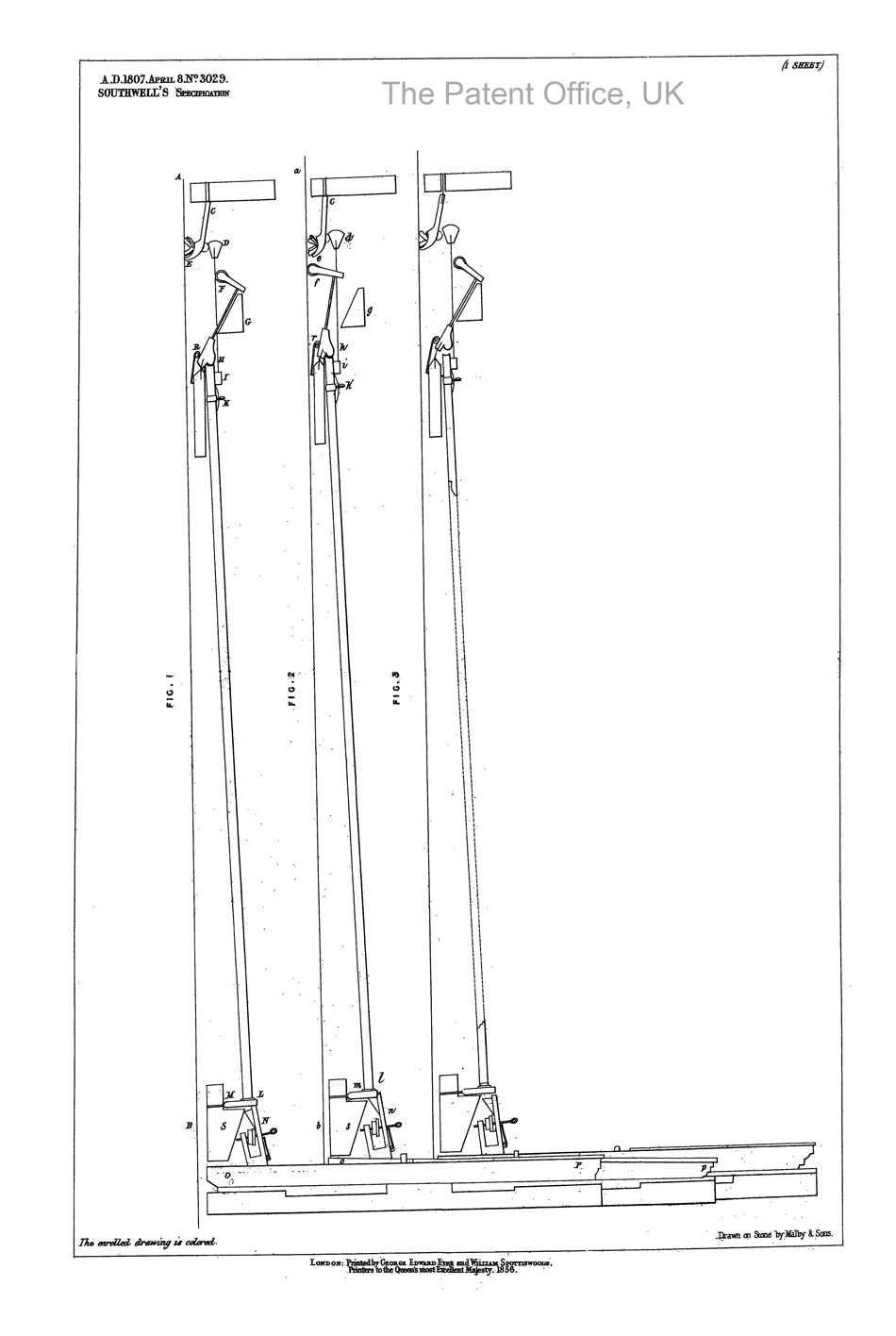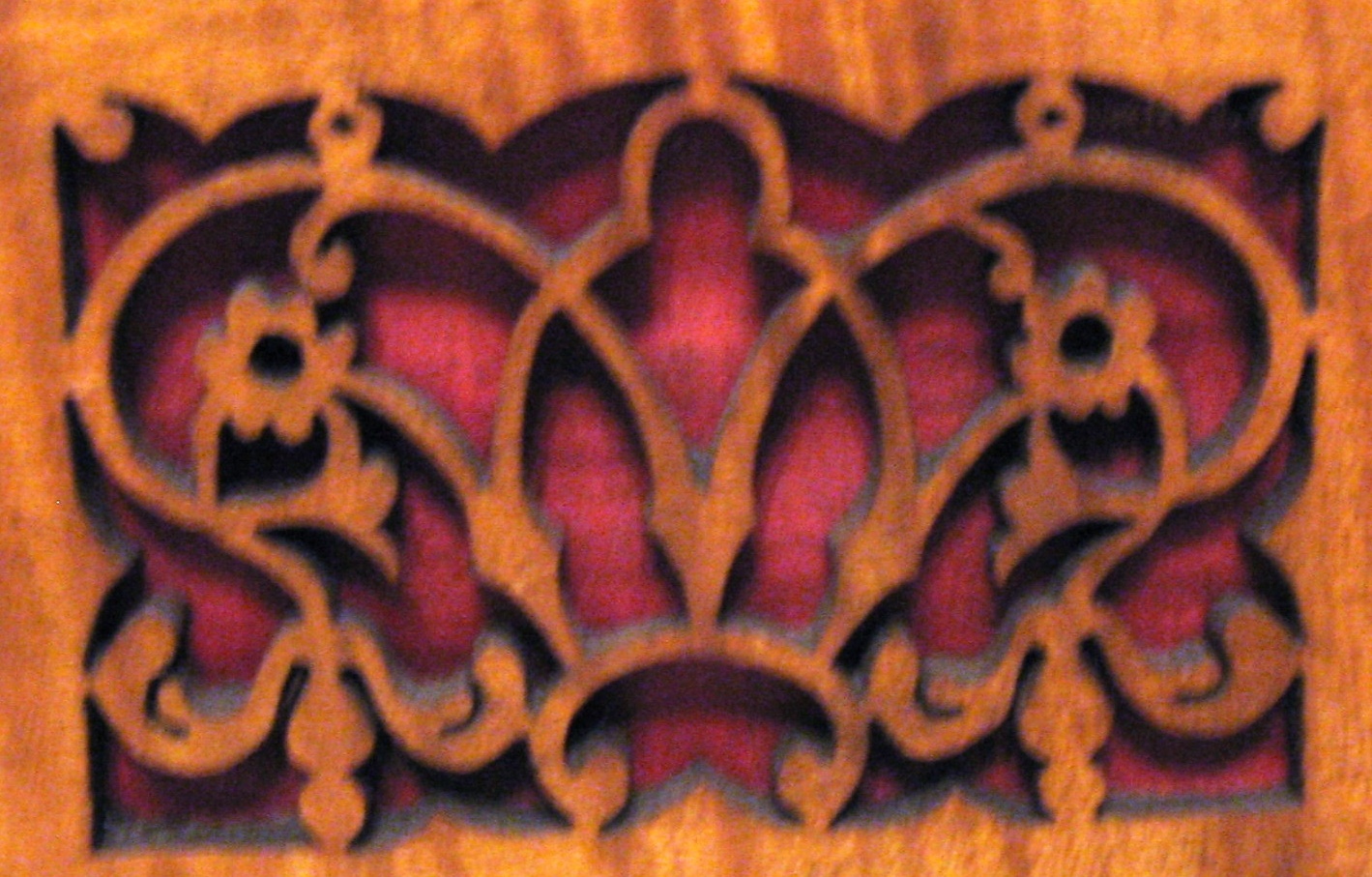William Southwell's Cabinet Pianoforte Patent of 1807 (No. 3029)
The Patent Office, UK
Patent Drawing

Transcription of the Specification
Text as given in the specification printed by George Edward Eyre and William Spottiswoode (1856). [New lines in the original document are indicated by ‘/’ ]SOUTHWELL'S SPECIFICATION
TO ALL TO WHOM THESE PRESENTS SHALL COME, I, WILLIAM /
SOUTHWELL, of the City of Dublin, Musical Instrument Maker, send greeting. /
WHEREAS His most Excellent Majesty King George the Third did, by /
His Letters Patent under the Great Seal of the United Kingdom of Great /
Britain and Ireland, bearing date at Westminster, the Eighth day of April, /
in the forty-seventh year of His reign, give and grant unto me, the said /
William Southwell, my exors [executors], admors [administrators], and assigns, His especial license, full power, /
sole privilege and authority, that I, the said William Southwell, my /
exors, admors, and assigns, during the term of years therein mentioned, should /
and lawfully might make, use, exercise, and vend, within England, Wales, /
and the Town of Berwick-upon-Tweed, my Invention of “Certain Improve– /
ments on a Pianoforte, which is so Constructed as to Prevent the Possibility /
of its being so frequently Out of Tune as Pianofortes now generally are, and /
which he denominates a Cabinet Pianoforte;” in which said Letters Patent /
there is contained a proviso obliging me, the said William Southwell, by an /
instrument in writing under my hand and seal, to cause a particular descript– /
tion of the nature of my said Invention, and in what manner the same is to be /
performed, to be enrolled in His Majesty’s High Court of Chancery within one /
calendar month after the date of the said recited Letters Patent, as in and by /
the same, relation being thereunto had, may more fully and at large appear. /
NOW KNOW YE, that in compliance with the said proviso, I, the said /
William Southwell, do hereby declare that my said Invention, and the /
manner in which the same is to be carried into effect and practice, /
are described as followeth, that is to say:— /
In Fig. 1 of the Drawing hereunto annexed, A, B, denotes one of the /
wires of a pianoforte standing upright or nearly so; C, E, is a damper, having /
its face at E in contact with the wire by virtue or in consequence of the action /
of the small wedge piece D against a projection or protuberance on the back /
of the said damper, which would otherwise hang perpendicularly by reason of /
the liberty of motion allowed by the hinge joint at C; F is the head of the /
hammer to be applied in striking the said wire; G is a block or stop against /
which the hammer bears slightly, when in the state of repose, by the action of /
a tender spring R; H is the place of contact between the connecting rod /
L, H, and the tail of the hammer; I is a small block or piece glued or fixed /
to the connecting rod, and serving to support the wedge piece D by means of /
a tail of wire bent to right angle, and screwed or driven in to the side of the /
wedge D; K, shews, by a side view, one of a sett [sic] of small round wooden /
pins, covered with leather, between which the connecting rod plays easily, /
while it is prevented from flying out of its place or receding from the string /
by the outer end of a central wire, which, being screwed into the center of each /
wooden pin, and is bended to a right angle and turned on one side over the /
said rod; L, M, is a short lever moveable on its hinge or joint at M as to the /
block S, and upon which said lever the rod L, H, stands, and is connected /
therewith by a facing of leather glued to both, so as to serve as a joint /
towards L; N is the grasshopper, constructed as usual, and O, P, is the key, /
both which are drawn merely for the purpose of elucidating my present /
description, since the same do not constitute any part of my said improvements. /
In the said Fig. 1, all the parts are shewn in the state of repose. /
In Fig. 2, where the same parts are denoted by the same letters, the key is /
represented as pressed down, whereby the inner extremity of the same is /
raised. The end of the grasshopper hath pressed up the connecting rod l, h, /
which, by its pressure on the tail of the hammer, hath caused it to give the /
stroke; and, at the same time, the wedge piece d hath risen and permitted the /
damper e, e, to fall into the perpendicular position and leave the string at /
liberty to vibrate on receiving the stroke. But on return of the key to its /
former position of repose, as in Fig. 1, the hammer moves back to its position /
against G, and the wedge piece D descends and presses the damper closely /
against the wire. /
Fig. 3 shews the same parts a little separated from each, in order that /
the respective forms may be better seen and understood. /
And I do properly place, dispose, and secure all the said parts, C, D, E, F, /
G, H, I, J, K, L, M, and S, in a square frame movable on a joint or hinge at /
bottom, so that its upper part shall be capable of advancing or receding with /
respect to the wires or strings; and I do cause the said frame to continue (by /
means of a spring) in the position necessary to keep the dampers and hammers /
at the due distance for action, as herein-before described, excepting when the /
dampers are to be thrown out of action, and in that case I press the said /
frame to the due distance by means of a pedal regulated by a stop, and /
constructed for that use and purpose. /
And I do further declare, that from the situation or relative position of the /
parts and apparatus herein-before described, I have rendered it unnecessary /
to make any opening or perforation between the sound board and the pin /
block or upper bridge, and that I do accordingly make the sound board of the /
instrument entire, and without any longitudinal hole or perforation, as is /
usually done, and that, in consequence of the said last-mentioned improve– /
ment, the structure of the instrument becomes much more firm and unchange– /
able, and the wires, being more effectually supported, are not so frequently out /
of tune as happens in instruments of the common constructions. /
Wm SOUTHWELL. (L.S.) /In witness whereof, I, the said William Southwell, have hereunto set my /
hand and seal, the Fifth day of May, in the year of our Lord One /
thousand eight hundred and seven. /
AND BE IT REMEMBERED, that on the Fifth day of May, in the year /
of our Lord 1807, the aforesaid William Southwell came before our said Lord /
the King in His Chancery, and acknowledged the Specification aforesaid, and /
all and everything therein contained and specified, in form above written. /
And also the Specification aforesaid was stampt according to the tenor of the /
Statute made for that purpose. /
Inrolled the Fifth day of May, in the year of our Lord One thousand /
eight hundred and seven. /
LONDON: /
Printed by George Edward Eyre and William Spottiswoode /
Printers to the Queen’s most Excellent Majesty. 1856. /




